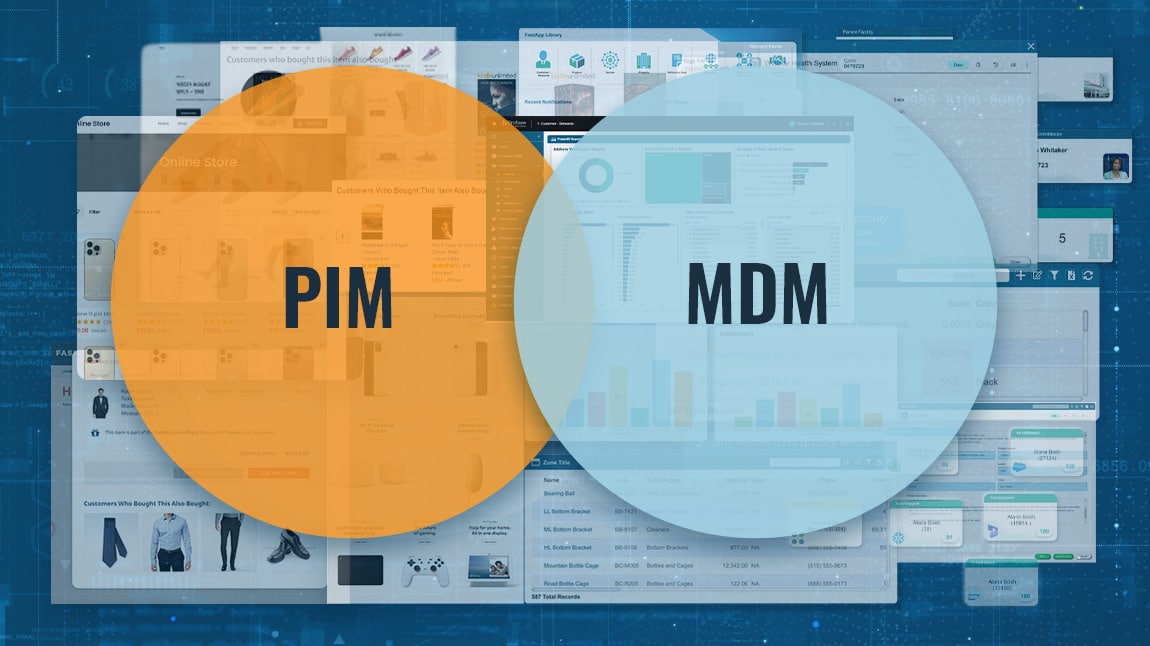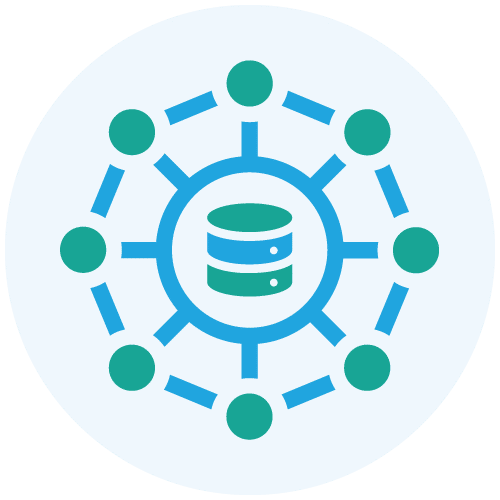PIM vs. MDM: Which Is Right For Your Organization?


Table of Contents
Understanding the nuances between product information management (PIM) and master data management (MDM) is crucial for data and analytics professionals seeking to optimize their organization’s data strategy. Both systems play a vital role in data governance and quality but cater to distinctly different needs.
Making an informed decision between PIM vs. MDM can significantly impact how your organization manages and utilizes data. This page will outline the benefits and uses of each system, provide a detailed comparison and address frequently asked questions.
Let’s get started!
Differences Between MDM and PIM
MDM is an overarching strategy and technological framework for managing critical business data across an enterprise. Its goal is to provide and maintain a single point of reference for all master data – including, but certainly not limited to, product data – by eliminating redundancies and inaccuracies.
By contrast, PIM is more specialized. It focuses on managing product-related information and assets in a centralized system and serves as the backbone for any company that distributes products through various channels, online or otherwise.
Refer to the table below for some key differences and similarities between MDM and PIM.
| Product Information Management (PIM) | Master Data Management (MDM) | |
|---|---|---|
| Primary business benefit | Provides the organization a single source of truth for product data and related assets, ensuring product listings and other marketing descriptions are up-to-date and consistent across all sales channels. | Provides the organization with trustworthy, high-quality data that can be used for trusted decision making. |
| Data domains managed | PIM software is only used to manage product data, generally with a strong focus on e-commerce. | Master data management can be used to manage any data domain, such as product, location or customer data. However, not every MDM tool can manage multiple domains. A good MDM solution should be multidomain, being able to manage multiple data domains at the same time. |
| Common features |
|
|
| Business problems address |
|
|
By equipping your team with the right system, you can streamline data processing and decision-making, enhance data accuracy and ensure consistency across different departments and channels.
Benefits of PIM
Product information management makes it simpler for companies to manage their product data efficiently. Here are specific benefits that a PIM solution provides:
Centralized product data
Collect product data from various sources and unify it in a central hub for easy management.
Enhanced data quality
Ensure accurate and up-to-date product descriptions, specifications, images and pricing which improve customer experience and satisfaction.
Efficient multichannel distribution
Push consistent product information to various sales channels, ensuring uniformity in the data presented to customers.
Improved time-to-market
Quickly introduce products across channels and maintain better relationships with vendors, suppliers and partners.
Benefits of MDM
Because MDM provides a broader approach in comparison to PIM, its benefits span the enterprise:

360-degree view of data
Obtain a unified view of all master data across organizational domains such as customer, location and product data

AI readiness
Deliver consumable data that’s ready for enterprise-wide AI initiatives

Trusted insights
Enhance decision making with accurate, high-quality data sourced across all business areas, data silos and source systems
Compliance and risk management
Reduce the risk of non-compliance with various regulations by maintaining correct and consistent data
Improved operational efficiency
MDM simplifies workflows to centralize and streamline data processes to reduce manual effort and automate more data-related tasks
MDM vs. PIM for Specific Use Cases
When deciding whether to adopt a PIM or an MDM system, consider the following specific use cases.
Use Cases for PIM
Use PIM when you need to…
- Optimize product data management for e-commerce platforms and multi-channel retailing
- Manage a large or a complex product catalog and keep information consistent across sales channels
- Easily localize product listings with the appropriate currency, units of measurement and language for a given area
- Provide customers with a user-friendly shopping experience through tools for self-service like filter by product category and search by product keyword
- Manage all product-related assets — from documents to images to videos — in a single repository
- Provide internal product managers and marketers a single interface for managing a high variety and volume of product-related data
- Pivot from only selling to wholesalers and distributors to distributing or selling products directly to end consumer
Use Cases for MDM
Use MDM when you need to…

- Manage master data and coordinate it across the enterprise
- Take a holistic approach to managing all enterprise data with an emphasis on governance, compliance and providing trustworthy data that supports enterprise-wide decision making
- Manage more than one data domain
- Get a 360-degree view of data from any domain — customer, product, location or something else
- Break down data silos and create consumption-ready golden records
- Improve data quality by enforcing data governance policies
While there may be some overlap, selecting the right system corresponds directly to your organizational goals for product information management and data asset management.
Two Common Misconceptions About PIM and MDM
PIM and MDM perform some of the same functions, which can be confusing when you’re trying to decide between the two. Let’s address two common misconceptions that people have about these critical components of an enterprise data strategy.
Misconception #1: “Having a PIM Solution Means You Don’t Need an MDM Solution.” (And Vice Versa)
One common mistake people make when it comes to PIM and MDM is thinking that implementing one eliminates the need for the other. To be clear, PIM and MDM are not the same. It’s true that they perform some similar functions, but neither one is a true replacement for the other.
The Facts
While PIM excels in managing product-specific information such as descriptions, images and specifications, MDM takes a broader approach, encompassing various master data domains beyond product data.
Therefore, organizations benefit from both PIM and MDM solutions working in tandem to ensure the coherence, accuracy and consistency of product information within the broader context of an enterprise-wide data strategy. (More on this later.)
Misconception 2: “We Already Have a PIM Solution. It’s a Waste of Money to Get an MDM Solution, Too.”
Similar to the first misconception, some people are under the false impression that investing in both PIM and MDM is redundant and, therefore, a waste of money. However, a closer examination reveals that, while there might be areas of intersection, the core mandates of PIM and MDM are distinct, each serving a specific purpose within the data management ecosystem.
The Facts
In practice, PIM is tailored to meet the unique challenges of managing product-related content, enriching the data for customer-facing channels and harmonizing product information across diverse touchpoints.
On the other hand, MDM extends its purview to encompass not only product data but also customer profiles, supplier records, medical provider records, bills of materials (BOMs) or recipes, branch locations — really any data domain an organization needs to coordinate across the enterprise.
The intersection between PIM and MDM does not negate their individual value propositions but rather strengthens the overall data management framework.
Can PIM and MDM Be Used Together?
Using PIM and MDM isn’t the right answer for every company, but many organizations realize benefits from implementing both systems — particularly those which manufacture the products they sell. Let’s consider two scenarios to illustrate this concept.
This is the heading
Example: Using a PIM to Manage Product Labels
First, let’s say a company needs to enrich its product data with data from other domains, like supplier and materials data. A PIM solution can handle the product data, but the company will also need to use MDM if it wants to improve data management and insights across its end-to-end product lifecycle.
This is especially important for manufacturing companies who need to accurately label products for downstream retailers. It would not be good, for example, if a food company inaccurately labeled a product as gluten-free if it did, in fact, contain gluten.
In this example, the company might use a PIM platform to integrate product data while using an MDM platform to create golden records for all of its master data — including product data.
This is the heading
Example: Multidomain Management
Now let’s consider a scenario where a company already has a PIM solution in place but needs to start managing other master data domains, like customer and location data. It may choose to integrate product data into its MDM platform in the future, but for now it’s content to use its PIM solution for product golden record management and its MDM solution for golden customer and location record management.
If the company was concerned about creating data silos, it could publish the golden product data to its MDM platform for data unification and use by downstream systems like business intelligence (BI).
PIM and Other Related Systems
In addition to MDM, people sometimes like to compare PIM against other related solutions for data management. Two types of software systems that people frequently consider are digital asset management (DAM) systems and product lifecycle management (PLM) systems.
PIM vs. DAM
Both PIM and digital asset management (DAM) systems are concerned with managing digital assets. While PIM predominantly concentrates on product-related information such as descriptions, specifications and attributes, DAM extends its jurisdiction to include a broader spectrum of digital assets, including images, videos, audio files and design documents.
The primary distinction between the two lies in their focal points:
- PIM revolves around the comprehensive management of product-specific information, orchestrating the harmonization of product data across multiple touchpoints to ensure a coherent and compelling consumer experience
- DAM centers on the curation and dissemination of digital assets, focusing on optimizing asset utilization and ensuring the discoverability and accessibility of digital content across the organization
While PIM augments the contextualization of product data, DAM accentuates the centralized control and utilization of digital assets beyond the product realm. That being said, PIM systems commonly include DAM capabilities, but they are also sold as separate systems.
PIM vs. PLM
Both PIM and product lifecycle management (PLM) systems lie at the intersection of product-centric data management. While PIM specializes in product data enrichment and syndication to sales channels, PLM assumes a more expansive role, overseeing the entire product lifecycle from conception to obsolescence and including features for digital twin creation, product design collaboration and documentation, change management, project management and more.
The key difference here is the intended user. PIM lends itself more towards retailers and wholesalers, while PLM is usually better suited for manufacturers. In some cases, of course, the manufacturer is also the seller — as in direct-to-consumer business models — but either way, PIM and PLM are unique tools that often serve different purposes and are not directly interchangeable.
Manage Your Product Data With Profisee MDM
In curating your data management tools, understanding the difference between PIM vs. MDM — and their specific benefits — is just the start. It’s important to align these systems with your organization’s strategic goals for a comprehensive, effective approach to data governance and management.
Profisee is a best-in-class, multidomain MDM system that is natively integrated with Microsoft Fabric so you can use trusted data in tools like Power BI and Azure Data Factory. Whatever master data you need to manage, Profisee allows you integrate data from any source — including popular PIM solutions — and clean and enrich it to create consumption-ready golden records for your downstream systems and end business users.
If you’re curious about how Profisee can help improve the quality of your product data, request a demo today to see why leading enterprises choose Profisee MDM for their data management needs.
FAQs About PIM and MDM
Yes, it is possible and often beneficial to integrate PIM within a larger MDM framework to gain the advantages of both systems. Product data mastered in an MDM hub can often be synced back to the PIM system to power product listings and other PIM use cases.
By leveraging the data governance capabilities of MDM platforms, organizations can establish and enforce data quality standards, data policies and data stewardship processes across both product data used by the PIM system.
It depends on the scope of your data management needs. If your data challenges go beyond product information, then MDM might be necessary. For example, if you need to manage not only product data but also customer data, supplier data, employee data, etc., then MDM is essential to provide a unified view of all master data domains.
Also, PIM systems often only provide rudimentary data quality and data governance features, so organizations with strict data governance requirements — such as ensuring data quality, consistency and compliance across various data domains — will benefit from implementing MDM alongside their PIM system.
Organizations operating in retail, manufacturing or distribution industries may require both PIM systems and MDM platforms. For example, a retail company might use a PIM system to manage product information for its online and offline sales channels while leveraging an MDM platform to manage customer data, supplier data and other master data domains to ensure a unified view of customers, optimize supply chain operations and support strategic decision-making.
PIM focuses solely on product data quality and distribution, which are directly related to what customers interact with during their purchasing journey. By leveraging comprehensive product data managed by PIM systems, organizations can personalize product recommendations, promotions and content based on customer preferences, increasing engagement and satisfaction.
However, an accurate, detailed product listing built from high-quality master data can also greatly enhance customer experience. This unified view enables personalized interactions, better customer service and more targeted marketing campaigns.
MDM systems help ensure compliance with data privacy regulations and protect customer data from unauthorized access or misuse, enhancing customer trust and loyalty.

Forrest Brown
Forrest Brown is the Content Marketing Manager at Profisee and has been writing about B2B tech for eight years, spanning software categories like project management, enterprise resource planning (ERP) and now master data management (MDM). When he's not at work, Forrest enjoys playing music, writing and exploring the Atlanta food scene.





